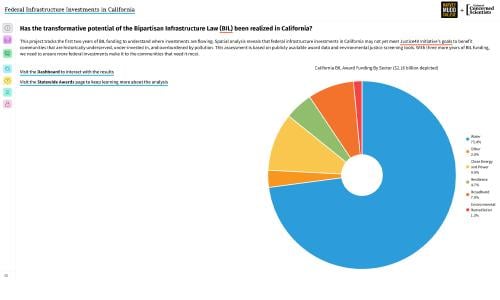According to new analysis, federal infrastructure investments in California may fall short of Justice40 Initiative goals.
In the past, federal infrastructure investments have left out or even harmed low-income communities and communities of color. Since 2021 and amid the climate crisis, the federal government’s Justice40 Initiative has sought to reverse this pattern. However, according to new UCS analysis, federal infrastructure investments in California may fall short of Justice40 Initiative goals of benefiting communities that have been harmed by underinvestment and overburdened by pollution.
The analysis is based on grant awards in California during the first two years of federal Bipartisan Infrastructure Law spending. With three years of this funding remaining, more federal investments must reach the communities that need them most. The United States needs a transparent, unified Justice40 tracking system that includes decisions about critical state-agency allocations to ensure equitable federal spending.
Follow the Money
This is a text-only version of the report. For a version with figures and tables, please download the full report.
Historic levels of federal infrastructure investments are providing once-in-a-generation opportunities to eliminate persistent environmental injustices. In the past, such investments have left out or even harmed low-income communities and communities of color. Since 2021 and amid the climate crisis, the federal government’s Justice40 Initiative has sought to reverse this pattern. It has set a goal that 40 percent of key federal investments benefit communities that have been marginalized, underserved, and overburdened by pollution. However, few, if any, systematic assessments of place-based progress toward Justice40 equity goals have been conducted.
To better understand where federal infrastructure investments are actually flowing, the Union of Concerned Scientists (UCS) has analyzed the first two years of Bipartisan Infrastructure Law (BIL) awards to communities in California. As the state with the most federal funding to date from the BIL, California represents a critical case for assessing progress toward Justice40 goals. It combines this historic level of federal funding with the state’s record of leadership in developing and using environmental justice screening tools to guide investments.
According to the analysis, local, non-transportation BIL investments in California may not be meeting Justice40 goals. The UCS spatial analysis assessed a subset of local BIL grants (241 awards) from federal fiscal years 2022 and 2023 in relation to two different environmental justice screening tools. Depending on the screening tool used, only 9.4 percent or 18.2 percent of the $779.29 million analyzed is flowing to communities designated and prioritized as “Disadvantaged.”
Improved BIL tracking and reporting may reveal that investments are closer than our analysis indicated to the Justice40 goal of 40 percent. Most BIL funding analyzed was allocated to state agencies without specific information about where projects would be performed; thus, data limitations prevented detailed analysis of this funding. Improved transparency and additional analysis of formula funding and statewide awards are needed to better know what funding is flowing to prioritized communities.
The UCS analysis highlighted the need for greater clarity regarding Justice40 implementation goals, as well as improved tracking to ensure that these historic infrastructure investments advance equity. Most important, we recommend the creation of a transparent, trackable definition of “benefits” under Justice40, accompanied by a clear process and timeline for the government to assess Justice40 progress. Among the opportunities to improve existing tools for tracking federal investments, we recommend improving the tracking of formula funding and non-formula statewide awards. With better tracking, individuals, community-based organizations, advocacy groups, and agencies could assess the final destination of these funds.
The US Bureau of the Fiscal Service, which manages the public clearinghouse on federal spending, can play a key role in this effort. We encourage it to improve the database on public government spending to facilitate future Justice40 analyses with better place-based information and enhanced compliance by federal agencies on submitting and reporting data. With improved transparency and additional analysis, BIL infrastructure investments can realize the transformative potential of Justice40.
A three-year window remains to get billions of dollars in infrastructure investments to communities where they are most needed. Understanding where investments have gone so far—as well as who is benefiting from this generational infrastructure investment—can help ensure federal dollars transform past patterns of inequity.
Downloads
Citation
Fencl, Amanda, Jenny Rempel, Georgia Klein, Mo Kyn, Ryder Mitchell, Allyson Yao, 2024. Follow the Money: Are Historic Infrastructure Investments Going to California Communities that Need It Most? Cambridge, MA: Union of Concerned Scientists. https://doi.org/10.47923/2024.15488




